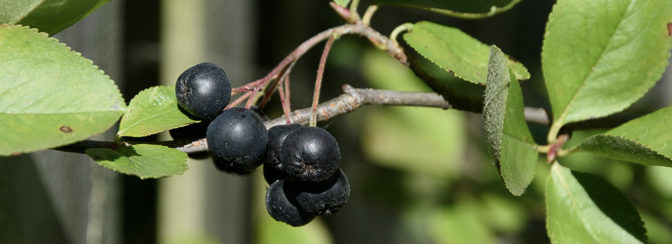Site Selection
Aronia need to be planted in full sun to be fruitful. The plants can survive in shade, but will bear little or no fruit.
Aronia will perform best on deep, fertile, moist but well-drained soil with high moisture-holding capacity, but without a high water table. Aronia will tolerate somewhat poorly drained soil as long as the water table is greater than 12 inches below the surface. Aronia will tolerate a pH range of 5.5 – 7.5.
Planting
Planting holes should be dug to accommodate the size and shape of the root system without bending or crowding the roots around the sides of the hole. Plants should be placed at the same depth they grow in the nursery: roots in the ground, trunks above ground. That said, Aronia are more tolerant of planting depth errors than most other trees and shrubs. Portions of the trunk that get buried below the soil line will root readily.
Maintenance
Aronia foliage and twigs are very attractive to deer and deer will go out of their way to browse on Aronia. Rabbits will readily snip Aronia off at ground level. If these animals are present, Aronia need to be protected from them. Because Aronia are relatively low-growing, multi-stemmed shrubs, the 5 foot tall solid tree shelters that are normally best for deer and rabbit protection just will not work. Eighteen inch tall plastic mesh shelters can provide very good protection from rabbits, but an effective deer repellent will need to be used in addition (such as Plant Skydd, or a home-made repellent from raw egg and water).
When newly planted, Aronia need effective protection from weed competition in order to survive and thrive. An organic method is to place a 3 foot square of landscape fabric around the base of each plant, and top it with 2 – 3 inch of coarse wood chips. This will provide effective weed control for the first year the plants re in the ground, but the landscape fabric must be removed after that as the plants send up shoots from an ever-widening root system. After that, a combination of 4 inches or more of a course wood chip mulch plus close, frequent mowing will have to suffice.
If organic standards are not an issue, a once-a-year treatment with one ounce per acre of Sulfometuron methyl herbicide (“Oust”) can keep a 3 foot diameter circle around the base of each plant weed free for a cost of only pennies per acre. Oust herbicide should be applied by a certified pesticide applicator with experience in sprayer calibration.
Once Aronia are well-established (4 – 5 years) they no longer need protection from weed competition.

